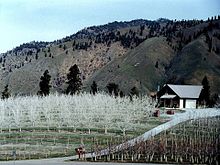Kaolin spray

Kaolin spray is a pest control that has kaolin as the main ingredient. The practice has been in recorded use from 2000 B.C.E. in China[citation needed]. More recent studies have shown that kaolin sprays can promote photosynthesis and are effective in reducing insects and disease on plants.
Description
[edit]Kaolin is a rock rich with the clay mineral kaolinite. Kaolin spray is a pest control that has kaolin as the main ingredient.
History
[edit]In nature, many animal species commonly take "dust baths" to rid themselves of insect parasites and prevent attacks from biting insects.[1] In 2000 B.C.E., records in China describe the application of mineral-based dusts (e.g., diatomaceous earth) to plants to control insects.[2] Subsequently, various mineral-based preparations have been used, and some of these remain in use for agricultural pest control.[3]
More recently, kaolin mixed with spreaders and stickers and applied to plants as a spray at 1–6% concentration in water form has been shown to be an effective approach to agricultural pest control and to protect plants from environmental stresses. Kaolin-based sprays have been studied extensively since 1999 and research has established that these sprays deposit a "particle film" that has numerous beneficial effects on plants and in insect pest control. Certain kaolin-based sprays can form a highly reflective white film over plant surfaces that enhances plant photosynthesis and reduce heat stress in plants, which they do by reflecting the infra-red light spectrum, which in improves plant yields and fruit quality in orchards.[4][5][6] The kaolin barrier created by the particle film also protects the treated plant surfaces from diseases,[7] and insects.[8][9][10][11][12][13]
See also
[edit]References
[edit]- ^ Ebling, W. 1971. Sorptive dusts for pest control. Annu. Rev. Entomol. 16:123–158.
- ^ Allen, F. 1972. A natural earth that controls insects. Org. Gardening & Farming 19:50–56.
- ^ Glenn, D., and G. J. Puterka. Particle Films: A new technology for Agriculture. Pp. 1-44. In J. Janick [ed.] HortReviews. Vol.31. John Wiley & Sons, Inc., Hoboken, NJ. 2005.
- ^ Glenn, D.M., G. J. Puterka, S. Drake, T. Unruh, A. Knight, A. Baherle, E. Prado, and T. Baugher. Particle film application influences apple leaf physiology, fruit yield, and fruit quality. J. Am. Soc. Hort. Sci. 2: 175-181. 2001.
- ^ Glenn, D.M., E. Prado, A. Erez, J. McFerson, and G.J. Puterka. A reflective, processed-kaolin particle film affects fruit temperature, radiation reflection, and solar injury in apple. J. Amer. Am. Soc. Hort. Sci. 127:188-193. 2002.
- ^ Glenn, D.M.; S. Drake; J. Abbott; G.J. Puterka, and P. Gundrum (2005). "Season and Cultivar Influence the Fruit Quality Response of Apple Cultivars to Particle Film Treatments". HortTechnology. 15 (2): 249–253. doi:10.21273/HORTTECH.15.2.0249. Retrieved November 25, 2015.
- ^ Glenn, D. M., van der Zwet, T., Puterka, G., Gundrum, P., Brown. E. 2001. Efficacy of kaolin-based particle films to control apple diseases. Plant Health Progress doi: 10.1094/PHP-2001-0823-01RS. 2001.
- ^ Puterka, G. J., and D. M. Glenn. Kaolin-Based Particle Films for Arthropod Control. pp. 2075-2080, In (J. L. Capinera, ed.) Encyclopedia of Entomology, Kluwer Academic Publishers. 2008.
- ^ Puterka, G. J., D. M. Glenn, D. G. Sekutowski, T. R. Unruh, and S. K. Jones. Progress toward liquid formulations of particle films for insect and disease control in pear. Environ. Entomol. 29: 329-339. 2000.
- ^ Knight, A. L., T. R.Unruh, B. A. Christianson, G. J. Puterka, and D. M. Glenn. 2000. Effects of a kaolin-based particle film on obliquebanded leafroller (Lepidoptera: Tortricidae). J. Econ. Entomol. 93: 744-749. 2000.
- ^ Unruh, T. R., A. L. Knight, J. Upton, D. M. Glenn, and G. J. Puterka. Particle films for suppression of codling moth (Lepidoptera: Tortricidae) in apple and pear orchards. J. Econ. Entomol. 93: 737-743. 2000.
- ^ Puterka, G. J., Reinke, M., Luvisi, D., Ciomperik, M. A., Bartels, D., Wendel, L., and Glenn, D. M. Particle film, Surround WP, effects on glassy-winged sharpshooter behavior and its utility as a barrier to sharpshooter infestations in grape. Plant Health Progress doi: 10.1094/PHP-2003-0321-01-RS. 2003.
- ^ Puterka, G. J., D. M. Glenn, and R. Pluta. Action of particle films on the biology and behavior of pear psylla (Psyllidae: Homoptera). J. Econ. Entomol. 98: 2079-2088. 2005.
